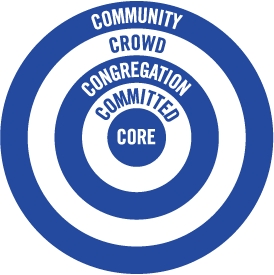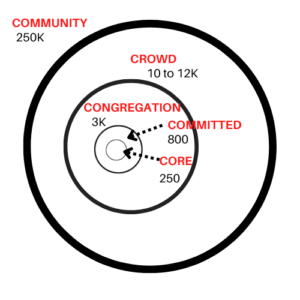How (and Why) to Draw Saddleback’s Concentric Circles to Scale
 If you've been along for much of this conversation, you know I love a good diagram.
If you've been along for much of this conversation, you know I love a good diagram.
Saddleback's "concentric circles" diagram has tremendous application and I've used it a lot to explain things like crowd to core strategy and engagement pathways.
 This version of the concentric circles diagram has been used many times to illustrate the general idea. I don't remember where I found it. Most likely on some Saddleback web page or online source. Regardless, it is representative of the concept presented in The Purpose Driven Church.
This version of the concentric circles diagram has been used many times to illustrate the general idea. I don't remember where I found it. Most likely on some Saddleback web page or online source. Regardless, it is representative of the concept presented in The Purpose Driven Church.
I like the diagram and have used it to teach the concept of crowd to core. When I want to be able to explain many of the nuances and finer points (identifying the gaps in strategy or connecting the gap between community and congregation), I prefer drawing my own version of community to core.
 The diagram to the left is my attempt to draw the circles to scale. At the time I initially drew this version, we had calculated that there were 250,000 unchurched adults in the 8 zip codes surrounding Canyon Ridge Community Church. That's how many people made up the "community."
The diagram to the left is my attempt to draw the circles to scale. At the time I initially drew this version, we had calculated that there were 250,000 unchurched adults in the 8 zip codes surrounding Canyon Ridge Community Church. That's how many people made up the "community."
The "crowd" number was determined by how many adults attended our Christmas Eve services. The "congregation" number was based on the number of adults in small groups. The "committed" number is an estimate of the adults leading groups and teams, giving generously, etc. And the "core" was based on even more exclusive characteristics (i.e., giving sacrificially, serving commitment, etc.).
How is it helpful to do the work of understanding the circles in your church? In my experience, looking carefully at the numbers can help shape the design of steps intended to encourage next step movement. These numbers can also shape things like budget, staffing, room allocations, etc.
Further Reading
Connecting the Gap Between Community and Congregation
Try This Simple Exercise to Identify Next Steps


I like your redraw of the Concentric Circle because as you said it allows you to see more with one diagram. This thought will be helpful to use in my future endeavors. Thank you for sharing.
Glad you found it helpful!